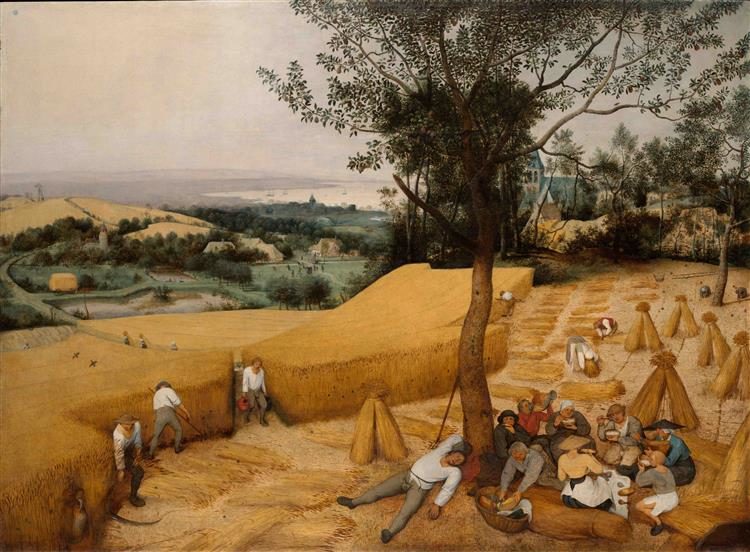In life we often take a lot for granted. Exhibit A: Consider the revolution in farming that took place over centuries.
Imagine being a farmer a century or more ago. You likely used animals or even your own muscle to move a plow forward, to furrow the soil in preparation for planting the seeds. Or perhaps you picked the harvest by hand.
We have some sense of how farmers worked generations ago, not only from stories and written-down accounts but also from paintings. Flemish artist Pieter Bruegel the Elder created one such work of art. His 1565 painting, The Harvesters, shows labourers gathering wheat and tying up the stacks up by hand.

That was “then,” nearly five centuries ago. Over the past two centuries since the Industrial Revolution — and over the past 100 years in particular, much farming worldwide moved from backbreaking labour for men, women, children and animals alike to increased mechanization.
Farmers moved from plowing and harvesting fields using animals and their own labour, to tilling fields with mechanized vehicles such as tractors. That change, and many others, allowed for a greater yield per hectare. That in turn translated into less physical work but often more income, and much more food to sustain growing populations worldwide.
In short, farmers produced much more food with much less effort. This is an example of the importance of labour productivity, and in particular of capital investment in machinery.
On this issue of productivity, there’s probably no greater disconnect between economists who talk about it and most people’s understanding of that concept. However, the revolution in farming is one clear example of why that obscure economic concept matters: a much better life for all.
Or, as the Business Council of BC describes it in more technical language, “a country’s standard of living ultimately depends on its labour productivity, that is, its ability to generate the highest possible level of income or output, per unit of labour input…”
In Canada, one of the most productive industries that exists is the oil and gas sector. Moreover, despite energy price gyrations, the oil and gas extraction sector has been an important contributor to Canada’s labour productivity over the past two decades—and, not coincidentally, to higher living standards for Canadians.
First the concept: As the government of Alberta described it in 2016, “the key drivers of labour productivity include skills and human capital, capital investment, and innovation.” Specific to oil and gas, “levels in this capital-intensive industry are high as output (or GDP) per worker and per hour worked is high because this industry uses relatively more capital than labour in its production processes.”
To grasp this, think again of the farmer example: 20 people on a farm cutting wheat and bundling it up by hand have much less labour productivity per hour than 20 people driving tractors. The output per person, and per hour, is massively higher with the capital investment of one tractor per worker.
It’s the same in the oil and gas sector. All the capital investment be it big vehicles in the oil sands or investments in technology to extract much more oil and natural gas with less labour is what leads to high per hour “outputs”.
Now the specifics in hard numbers, specifically, dollars per hour, and with comparisons to other industries and over time.
Labour productivity in the broad oil and gas extraction sector was worth $936 per hour in 2000, dropping to $402 per hour as of 2012, rising again to nearly $700 per hour as of 2019, the most recent year available for this statistic.
Some sub-sectors in oil and gas extraction have lower productivity than that nearly $700 per hour and some higher. For example, pipeline transportation labour productivity was worth “just” $414 per hour in 2019. Conventional oil and gas extraction productivity was measured at $514 per hour with non-conventional extraction, i.e., the oil sands, at $1,090.
In comparison, the average labour productivity for all Canadian industries taken together was much lower (than oil and gas extraction) and within a much narrower range. In 2000, average labour productivity per hour for all industries was just $50, a figure that moved to just $60 per hour by 2019.
Broken down further, here are some other Canadian industries and their labour productivity measured in dollars per hour, in 2019: mining ($196 per hour); the telecommunications sector ($169); real estate ($149); finance and insurance ($77); motor vehicles ($75); and aerospace products and parts ($68 per hour).
Some industries fell below the all-industry average of $60 per hour for labour productivity. They included agriculture, forestry, fishing and hunting ($54); transportation and warehousing ($51); construction ($49); retail ($33); arts, entertainment and recreation ($28) and accommodation and food services ($23 per hour).
Expressed differently, oil and gas extraction at $700 per hour in 2019 was nearly twelves times as productive than the all-industry average of just $60 per hour.
That kind of productivity, much like the revolution in farming over centuries, can easily be taken for granted.
But that would be a mistake. While labour productivity is not an intuitively understood concept, it matters.
That’s because high labour productivity in oil and gas extraction has led to doing much more with less (your home is a lot easier to heat with natural gas than chopped wood) but also to significantly higher wages, higher investment by industry, more taxes and royalty revenues for governments, and much, much else that contributes to a higher standard of living for Canadians.
Mark Milke and Lennie Kaplan are with the Canadian Energy Centre, an Alberta government corporation funded in part by carbon taxes. They are authors of the report, $60 vs. $700 per Hour: Labour Productivity in Oil and Gas Extraction Compared with Other Industries.
